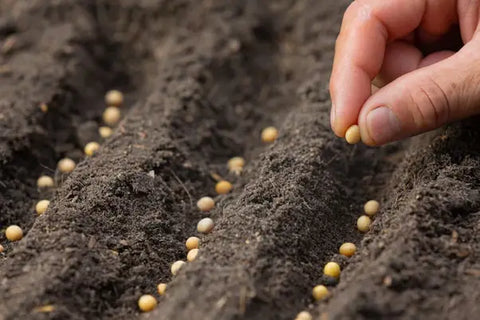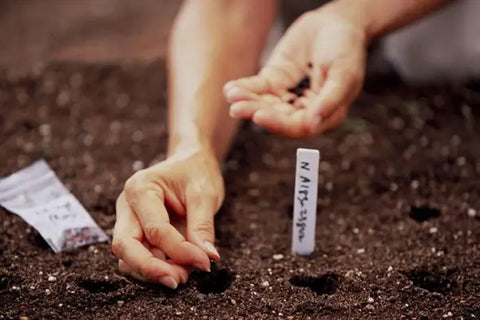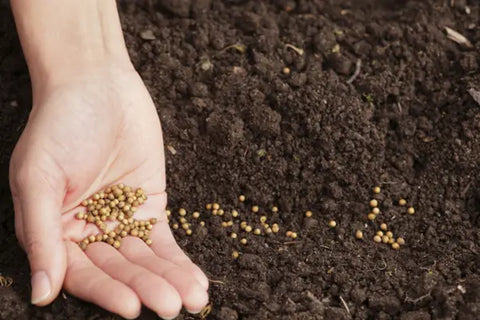Sowing vs Planting Seeds: Explained
Sowing seeds and planting seeds are both methods of growing plants, but they involve different processes and techniques. One of the popular questions in gardening is “what is the difference between sowing seeds and planting seeds?”. In this article, we will discuss in detail this concern.
1. What is the difference between sowing seeds and planting seeds? - Pros and cons
Planting seeds and sowing seeds are two methods of starting a garden or farm. While both methods involve placing seeds into the soil, they differ in terms of the technique used and the results obtained. Here are some of the pros and cons of planting seeds and sowing seeds:

1.1 Pros of Sowing Seeds:
Cost-effective
Sowing seeds is an inexpensive way to start a garden or farm as it only requires basic tools such as a shovel or hoe, and the seeds themselves.
Greater Diversity
Sowing seeds allows for a greater diversity of crops to be grown, as different varieties can be sown in different areas of the garden or farm.
More Control
Sowing seeds provides greater control over the spacing and density of the plants, allowing for better management of resources such as water and fertilizer.
1.2 Cons of Sowing Seeds:
Inefficiency
Sowing seeds can be more time-consuming for plants to grow than planting seeds.
Uneven Germination
Sowing seeds can result in uneven germination rates, as the seeds may not be placed at the optimal depth or may be affected by factors such as weather conditions or pests.
Greater Risk
Sowing seeds may be more vulnerable to damage or destruction from factors such as birds, pests, or weather events, which can result in a lower overall yield

1.3 Pros of Planting Seeds:
Precision
Planting seeds involves placing the seedlings at precise intervals and depths, ensuring that each seedling has sufficient space to grow and thrive.
Efficiency
Planting seeds can be faster than sowing seeds as it can be done using machines or tools such as dibbers or seed drills, which can cover a larger area in less time.
Better Germination
Planting seeds typically results in better germination rates as the seedlings are planted at the optimal depth, providing them with the necessary moisture and nutrients to sprout.
1.4 Cons of Planting Seeds:
Equipment Cost
Planting seeds requires specialized tools, such as seed drills or planters, which can be expensive to purchase or rent.
Limited Diversity
Planting seeds can limit the diversity of crops grown, as it is not always practical to plant many different crops using the same equipment.
Less Control
Once the seedlings are planted, it can be more difficult to control the spacing and density of the plants, which can affect the growth and yield of the crops.
Both planting seeds and sowing seeds have their advantages and disadvantages, and the choice of method will depend on the specific needs and circumstances of the garden or farm. It may be helpful to consider factors such as cost, efficiency, diversity, and control when deciding which method to use.
2. Sowing seeds vs planting seeds: which is better?
Sowing seeds and planting seeds are two methods of starting a garden or farm. While both techniques have their benefits, which one is better depends on various factors such as the type of crop, the soil condition, the climate, and the available resources.

Sowing seeds involves scattering seeds directly onto the soil surface without making any holes. This method is commonly used for small seeds such as lettuce, spinach, and carrots. Sowing seeds is usually done in the early spring, and the seeds are covered with a thin layer of soil. This method requires less preparation and is suitable for crops that have a short growing season. It also allows for the natural spacing of the plants, and the seedlings can be thinned out later.
Planting seeds, on the other hand, involves digging holes in the soil and planting seeds at a certain depth. This method is typically used for larger seeds such as beans, corn, and tomatoes. Planting seeds requires more preparation, including tilling the soil, adding fertilizers and compost, and creating rows. This method is suitable for crops that have a longer growing season, as it provides better protection for the seeds and allows for deeper root growth.
Which method is better depends on the type of crop and the available resources. For example, sowing seeds may be better for small gardens or for crops that require less maintenance, while planting seeds may be better for larger gardens or for crops that require more care.
In general, both sowing seeds and planting seeds have their advantages and disadvantages. The decision on which method to use should be based on the specific needs of the crop and the resources available. Ultimately, proper care and attention are necessary for both methods to yield a successful harvest.
3. Where to buy premium seeds for your garden?
As a premium seed supplier, The Rike takes pride in offering the highest quality seeds for all your gardening needs. Our seeds are carefully selected and tested to ensure germination rates, growth rates, and yield. We offer a wide range of premium seeds, including hundreds of heirloom, rare, and hard-to-find flower seeds, vegetable seeds, and herb seeds for both the home gardener and the wholesale trade,...
We understand the importance of providing reliable and consistent products, and our team is dedicated to providing exceptional customer service and support. Whether you are a home gardener or a professional grower, we have the knowledge and expertise to help you achieve success with your planting endeavors. Trust us as your go-to supplier for premium seeds that will help you grow healthy, robust plants and bountiful harvests.
Discover our collection: The Rike Seasonal Seeds
4.Finally,
Sowing seeds and planting seeds are two different methods of starting a plant. Sowing seeds involves scattering seeds over the soil surface while planting seeds involves digging holes in the soil and placing seeds in them. Both methods have their advantages and disadvantages, and the choice of method depends on the type of plant being grown, the soil conditions, and the grower's preferences.





Leave a comment